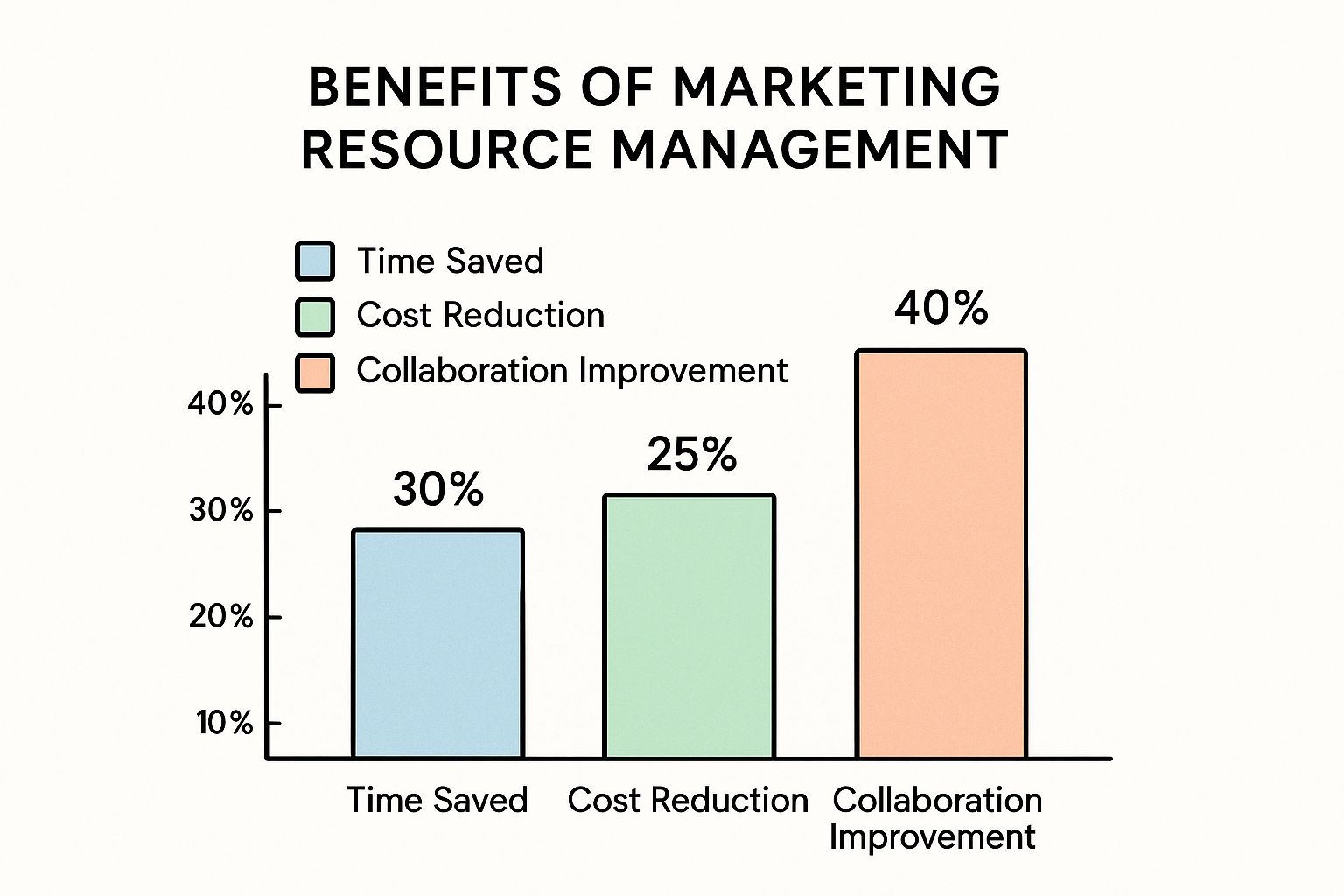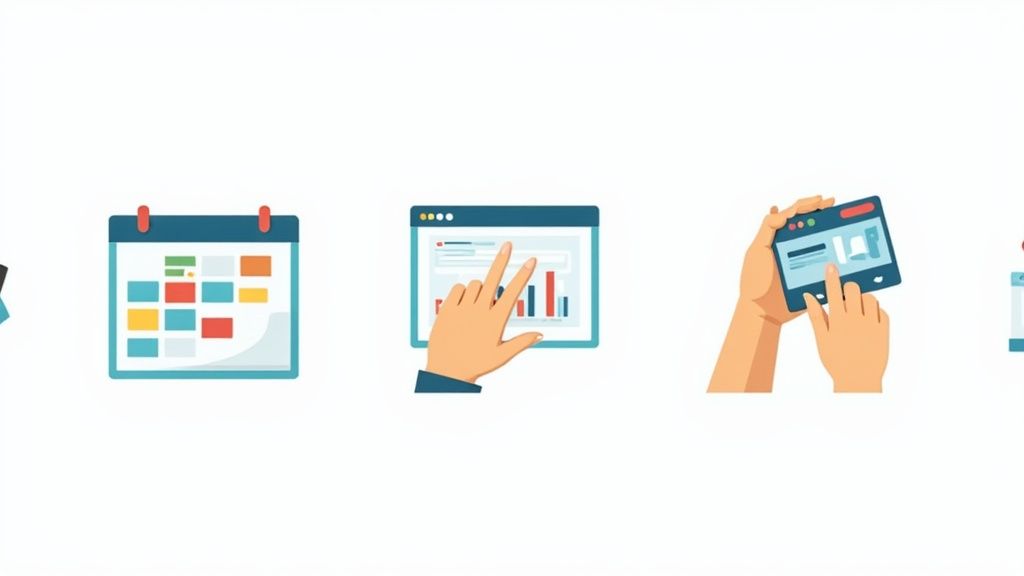Understanding Modern Marketing Resource Management

Marketing Resource Management (MRM) has evolved significantly. Originally designed for simple asset storage, it has become a crucial operational center for marketing teams, acting as the central nervous system for successful marketing organizations. Modern MRM platforms connect various essential elements: workflows, digital assets, budgets, and analytics. This creates a unified system that promotes efficiency and growth.
This interconnectedness allows teams to orchestrate campaigns, manage resources, and analyze performance with unprecedented clarity.
Key Components of True MRM
True MRM solutions differentiate themselves from other marketing technologies through their integrated approach. They go beyond managing a single aspect of marketing and connect all the pieces. Here’s a breakdown of the key components:
- Workflow Management: This component ensures projects progress seamlessly through different stages, from initial idea to final completion. An automated system routes tasks, manages approvals, and tracks progress in real-time, minimizing delays and keeping everyone on the same page.
- Digital Asset Management: Centralizing all marketing materials eliminates the difficulties of scattered files and version control problems. Having a single source of truth for all assets, accessible to the right individuals at the appropriate time, streamlines creative processes.
- Budget Management: MRM provides essential visibility and control over marketing spending. It enables accurate budget allocation, real-time expense tracking, and detailed reporting. This transparency facilitates data-driven decisions and accountability.
- Analytics and Reporting: Integrated analytics dashboards provide a clear overview of marketing performance. This helps pinpoint successful strategies, areas needing improvement, and where to allocate resources for maximum impact. Data-driven insights become the basis for continuous improvement.
The Growing Importance of MRM
This integrated approach is becoming increasingly valuable in the modern marketing environment. The marketing resource management (MRM) market is experiencing substantial growth. In 2024, the market was valued at approximately $6.2 billion. Projections indicate it will reach $7.17 billion by 2025, representing a 15.7% compound annual growth rate (CAGR).
This growth is driven by the need for improved efficiency, better team collaboration, and data-driven decision-making. Additionally, the need to control costs and comply with regulations contributes to this expansion. Factors such as increasing integration of AI and automation, along with growing concerns about security and privacy, are shaping the future of this market. You can find more detailed statistics here: Learn more about the MRM market. This rapid growth underscores the increasing recognition of MRM as a vital tool for modern marketing success.
Quantifiable Benefits That Drive MRM Adoption

Beyond the hype, what tangible results are companies seeing with Marketing Resource Management (MRM)? The answer lies in significant improvements across key performance indicators. MRM helps connect workflows, assets, budgets, and analytics into a cohesive system, driving real business value. This allows for efficient resource allocation, streamlines operations, and offers data-driven insights.
Streamlined Operations and Efficiency Gains
MRM solutions are powerful tools for increasing efficiency. Many companies report a 30-50% reduction in campaign launch times. This increased speed doesn’t compromise quality. In fact, MRM helps maintain brand consistency, even across global markets, by providing a single source of truth for all marketing materials.
This centralized system eliminates version control issues and ensures everyone uses the most up-to-date assets. These efficiencies free up valuable time and resources for strategic initiatives.
Improved Budgetary Control and ROI
MRM transforms budget management from guesswork into a transparent and accountable system. This means marketing leaders gain better control over their spending and can demonstrate a clear return on investment (ROI). Instead of unexplained budget discrepancies, MRM offers real-time expense tracking and detailed reporting.
This increased visibility helps justify marketing spend to stakeholders and ensures resources are used effectively. For more information, you might be interested in: ReachLabs sitemaps.
Enhanced Collaboration and Reduced Silos
One of the most significant benefits of MRM is its ability to break down departmental silos. This means previously disconnected teams can collaborate more effectively, sharing information and resources seamlessly. Improved communication leads to better alignment between marketing and other departments, such as sales and finance.
This cross-departmental collaboration fosters a more cohesive and productive work environment.
Measuring the Impact: Real-World Examples
The impact of MRM can be seen in various areas, from operational efficiency to creative productivity and marketing intelligence. The following data, visualized in the data chart below, demonstrates the improvements achieved by a sample of companies after implementing an MRM solution.
| Metric | Before MRM | After MRM | Improvement |
|---|---|---|---|
| Campaign Launch Time (Days) | 28 | 14 | 50% |
| On-Time Project Completion | 65% | 90% | 25% |
| Brand Consistency Score | 7.5 | 9.2 | 1.7 |
| Marketing ROI | 2.5x | 4x | 1.5x |
The data chart clearly illustrates significant improvements achieved after MRM implementation. Campaign launch times were halved, on-time project completion increased by 25%, brand consistency saw a noticeable boost, and marketing ROI more than doubled. This data provides compelling evidence for the value of MRM in driving tangible, quantifiable results. These improvements represent a significant shift in marketing performance.
The following table summarizes the benefits of MRM implementation across different organization sizes.
Marketing Resource Management Benefits by Organization Size
This table shows how different sized organizations benefit from MRM implementation with specific metrics and outcomes.
| Benefit Category | Small Businesses | Mid-sized Companies | Enterprise Organizations |
|---|---|---|---|
| Campaign Launch Time Reduction | 20-30% | 30-40% | 40-50% |
| Improved On-Time Project Completion | 15-20% | 20-25% | 25-30% |
| Increase in Brand Consistency Score | 1.0-1.5 | 1.5-2.0 | 2.0-2.5 |
| Marketing ROI Improvement | 1.2x-1.5x | 1.5x-2.0x | 2.0x-2.5x |
Smaller organizations experience notable benefits, while larger enterprises see even more substantial improvements across the board, demonstrating the scalability and adaptability of MRM.
Essential Features That Power High-Performing MRM Systems

This section explores the core functionalities that transform Marketing Resource Management (MRM) systems from basic organizational tools into dynamic operational centers. These features are essential for optimizing marketing operations and maximizing ROI. Understanding these components helps businesses select the perfect MRM solution to meet their unique needs.
Robust Digital Asset Management: The Foundation of Efficiency
A cornerstone of any high-performing MRM system is robust digital asset management (DAM). This functionality provides a single, centralized repository for all marketing materials. This eliminates the disarray of scattered files and mitigates version control problems. Imagine a well-organized library where every marketing asset—images, videos, presentations, and documents—is meticulously cataloged and easily accessible. This ensures teams always use the most current versions, maintaining brand consistency and preventing costly errors. Many DAM systems also incorporate features for managing usage rights and licenses, offering further legal protection.
Intelligent Workflow Systems: Streamlining the Marketing Process
Effective MRM systems go beyond simple storage by incorporating intelligent workflow systems. These systems automate task routing, manage approvals, and offer real-time progress tracking. Consider an automated approval process for marketing collateral. Instead of emails and attachments circulating for weeks, the MRM system automatically routes materials to the appropriate stakeholders, tracks their feedback, and manages revisions within a unified platform. This significantly shortens review cycles, often reducing them from weeks to days, boosting productivity, and freeing up marketing teams for strategic initiatives.
Budget Management: Clarity and Control
Comprehensive budget management is another vital feature. High-performing MRM systems offer unparalleled visibility into marketing spend, enabling finance teams and marketers to communicate effectively using the same financial data. This transparency promotes accountability and facilitates data-driven decisions, ensuring efficient resource allocation. Think of it as a real-time financial dashboard for your marketing operations, allowing you to track budget allocation, monitor expenses, and generate detailed reports effortlessly. This empowers marketing leaders to demonstrate clear ROI and confidently justify budget requests.
Seamless Integrations: Unifying Your Marketing Technology
Integration with existing technologies is paramount for MRM success. Effective MRM platforms connect seamlessly with other MarTech tools like CRM and marketing automation platforms. This ensures smooth data flow and prevents data silos. Integrating your MRM with your CRM, for instance, allows you to align marketing campaigns with sales efforts, providing a holistic view of the customer journey. Choosing an MRM with strong integration capabilities maximizes the value of your current technology investments.
Actionable Analytics: Driving Data-Driven Decisions
Finally, high-performing MRM systems go beyond visually appealing dashboards. They provide actionable analytics that offer deep insights into marketing performance. Rather than just reporting on surface-level metrics, these systems help you understand why certain campaigns succeed or fail. This allows you to identify areas for improvement, optimize resource allocation, and make data-driven decisions that yield tangible results. This granular analysis empowers marketers to continually refine their strategies and maximize their impact.
To better understand the key features available in leading MRM platforms, let’s take a look at the following comparison:
Top MRM Platform Features Comparison
Detailed comparison of essential features across leading Marketing Resource Management platforms
| Feature Category | Basic Functionality | Advanced Capabilities | Integration Potential |
|---|---|---|---|
| Digital Asset Management | Storage, tagging, search | Version control, usage rights management, automated workflows | Integration with CRM, CMS, marketing automation |
| Workflow Management | Task assignment, approval routing | Automated notifications, real-time progress tracking, custom workflows | Integration with project management tools |
| Budget Management | Budget tracking, expense reporting | Forecasting, scenario planning, ROI analysis | Integration with accounting software |
| Analytics & Reporting | Basic performance metrics | Customizable dashboards, advanced analytics, predictive modeling | Integration with business intelligence tools |
This table highlights the range of functionalities offered by MRM platforms, from basic features to more advanced capabilities. When selecting a platform, consider your organization’s specific needs and growth plans.
Choosing the right MRM system can greatly enhance your marketing operations and drive significant business growth. Carefully evaluate the features discussed above to ensure your chosen platform aligns with your overall marketing strategy.
Implementing Marketing Resource Management Successfully
Successfully implementing Marketing Resource Management (MRM) is critical for maximizing its potential. Many promising MRM projects unfortunately fail due to inadequate planning and execution. This section explores practical strategies for a smooth and effective MRM rollout, from careful pre-implementation planning to post-launch monitoring and optimization.
Pre-Implementation: Laying the Groundwork for Success
Before implementing your new system, a thorough stakeholder analysis is essential. This involves identifying all individuals or teams affected by the MRM system. Understanding their needs and concerns will allow you to address potential roadblocks proactively. For example, early engagement with the creative team, addressing their concerns about workflow changes, can ensure buy-in and prevent future resistance.
A phased approach to implementation is often better than a complete system overhaul. Starting with a pilot program focused on a specific marketing function, such as digital asset management, generates quick wins. This demonstrates the value of MRM and builds momentum for broader adoption. Additional functionalities can then be added in stages, making the transition smoother and allowing for adjustments along the way.
Navigating Implementation Challenges
Data migration is a common pitfall in MRM implementations. Meticulous planning is essential for cleaning, mapping, and validating existing marketing data before transferring it into the new system. Just as you wouldn’t move broken furniture into a new house, ensure your data is clean and organized for a seamless transition.
Avoid excessive customization during the initial implementation. While tailoring the system is important, over-customization can increase complexity, costs, and integration issues. Start with the core features. Gradually add customization as needed, based on real-world usage and user feedback.
MRM systems often integrate with platforms like Marketing Automation. For more information on related topics, consider exploring resources such as the ReachLabs Sitemap.
Driving User Adoption: The Key to Long-Term Success
Effective training programs are crucial for user adoption. Focus on demonstrating the value of the MRM system to individual users, rather than simply requiring its use. Hands-on training, clear documentation, and ongoing support are vital. Without proper training, even the most powerful MRM system will be underutilized.
Measuring Success: Beyond the Go-Live Date
Successful implementation extends beyond the initial launch. Ongoing optimization and tangible benefits are key. Establish clear metrics to measure the impact of MRM on areas like campaign launch times, budget efficiency, and team collaboration. Regularly review these metrics and make adjustments as needed to ensure the MRM system continues delivering long-term value and drives sustainable marketing success.
Overcoming Marketing Resource Management Roadblocks

Even with the best laid plans, implementing Marketing Resource Management (MRM) can be challenging. This section explores common roadblocks and offers proven strategies for navigating them, turning potential setbacks into successes. By understanding these pitfalls and employing the right tactics, organizations can ensure a smoother transition and maximize their MRM investment.
Fostering User Adoption and Building Buy-In
One of the biggest hurdles is user adoption. Simply requiring the use of a new system often breeds resistance. Instead, focus on demonstrating the value of MRM to individual users.
For example, show how the system simplifies their workflows, reduces tedious tasks, and provides access to valuable resources. This value-driven approach encourages buy-in and fosters a positive attitude towards the system.
Mastering Data Migration: A Critical Step
Data migration can be a significant roadblock. Think of it as moving to a new home: disorganized packing leads to chaos in your new space. Similarly, migrating messy data into your MRM system creates future problems.
A structured approach involving data cleaning, mapping, and validation is crucial. This ensures data integrity and sets the stage for accurate reporting and analysis. To further enhance your marketing ROI, consider content repurposing strategies to maximize resource utilization.
Navigating Integration Complexities
Integrating MRM with existing MarTech tools can be complex. Successful teams prioritize seamless data flow. This may involve collaborating with IT or integration specialists to ensure compatibility.
These integration points elevate MRM from a standalone system to a central hub connecting all marketing activities. This integration is key to unlocking the full potential of your marketing technology stack.
Addressing Resistance to Change
Resistance to change is natural. Open communication and proactively addressing user concerns are vital. Regular training sessions, clear documentation, and ongoing support build user comfort with the new system.
Learning a new system takes time and practice; mastering a new MRM platform requires patience and support.
Real-World Examples of Overcoming Challenges
Many organizations have successfully navigated these roadblocks. One company initially struggled with user adoption. By implementing a comprehensive training program and providing dedicated support staff, they significantly increased user engagement.
Another organization faced data migration challenges. Through careful planning and execution, they successfully migrated their data, ensuring a smooth transition to their new MRM system. These examples demonstrate that with the right approach, even complex challenges are surmountable.
Building a Framework for Success
A well-defined framework for addressing these roadblocks is essential. This framework should include:
- Proactive Communication: Regularly update stakeholders on progress and address concerns.
- Value Demonstration: Showcase the benefits of MRM for individual users and teams.
- Phased Implementation: Roll out the system in stages to manage complexity.
- Ongoing Support: Provide continuous training and support after launch.
By proactively addressing these potential roadblocks, organizations can ensure successful MRM implementation and maximize the benefits of this powerful tool. This proactive approach transforms MRM from a potential challenge into a driver of marketing success.
The Evolving Future of Marketing Resource Management
The field of Marketing Resource Management (MRM) is constantly changing, going beyond the basics of simple coordination. New technologies are reshaping what MRM can do, pushing the boundaries of these systems. This means organizations need to adapt to stay ahead and leverage these advancements.
The Rise of Artificial Intelligence in MRM
Artificial intelligence (AI) is transforming resource management. One key area is predictive analytics, which anticipates future resource needs and potential bottlenecks. Imagine an MRM system predicting a surge in project requests and automatically allocating resources to handle the increased workload.
AI also powers intelligent content tagging for faster, more accurate searching of digital assets. This eliminates the frustration of endless folder searches, allowing marketers to quickly find what they need. Automated workflow routing, another AI-driven capability, ensures tasks are assigned to the right people at the right time, minimizing delays and optimizing workflow efficiency.
Enhanced Visualization for Improved Planning
Leading organizations use enhanced visualization tools to improve resource planning. These tools provide intuitive interfaces and real-time dashboards, offering a clear view of resource allocation, project timelines, and budget utilization. Marketing leaders can make informed decisions based on current data and identify potential problems early. For instance, a real-time dashboard might highlight a project falling behind schedule, enabling the marketing manager to intervene.
The Next Generation of Collaboration
The future of MRM includes enhanced collaborative features designed for global and dispersed teams. These tools facilitate seamless communication across time zones and departments. Think of virtual workspaces where team members from different countries can collaborate on projects, share ideas, and access resources in real time. This creates a more connected and productive work environment. You might be interested in: ReachLabs additional resources.
Preparing for the Future of MRM
Adapting to these advancements requires a proactive approach. Organizations should prioritize continuous learning and stay informed about the latest MRM trends. This includes investing in training to equip teams with the necessary skills. Organizations should also regularly evaluate their MRM systems and consider upgrading to platforms with advanced capabilities. Embracing these changes is crucial for maximizing efficiency, optimizing resource allocation, and staying competitive. This proactive approach will help marketing teams thrive and achieve greater success.
Ready to optimize your marketing operations and unlock your team’s full potential? ReachLabs.ai offers various services, from strategic planning to creative execution, designed to help you achieve your marketing goals. Visit ReachLabs.ai today to learn more and discover how we can help your business thrive.





